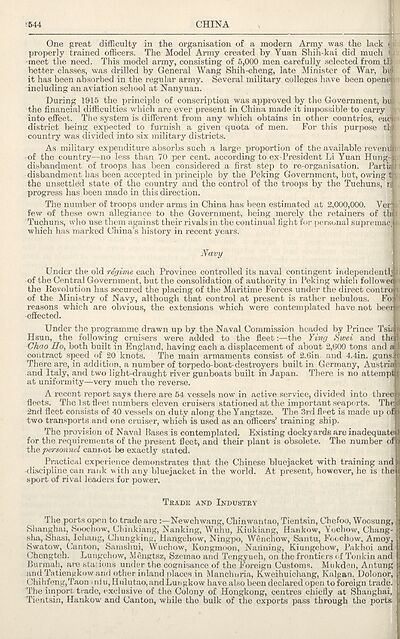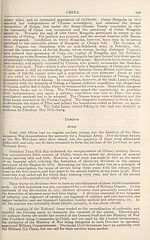1926
(600) Page 544
Download files
Complete book:
Individual page:
Thumbnail gallery: Grid view | List view

■544
CHINA
One great difficulty in the organisation of a modern Army was the lack <
properly trained officers. The Model Army created by Yuan Shin-kai did much i n£
meet the need. This model army, consisting of 5,000 men carefully selected from tH .m
better classes, was drilled by General Wang Shih-cheng, late Minister of War, bii
it has been absorbed in the regular army. Several military colleges have been opena Is
including an aviation school at Nanyuan.
During 1915 the principle of conscription was approved by the Government, bi 1
the financial difficulties which are ever present in China made it impossible to carry h
into effect. The system is different from any which obtains in other countries, ead h
district being expected lo furnish a given quota of men. For this purpose tlj
country was divided into six military districts.
As military expenditure absorbs such a large proportion of the available reveni :s
of the country—no less than 70 per cent, according to ex-President Li Yuan Hung-! n
disbandment of troops has been considered a first step to re-organisation. Parti; 1
disbandment has been accepted in principle by the Peking Government, but, ow’ing t j;
the unsettled state of the country and the control of the troops by the Tuchuns, b h
progress has been made in this direction.
The number of troops under arms in China has been estimated at 2,000,000. Verj K
few of these own allegiance to the Government, being merely the retainers of th 1
Tuchuns, who use them against their rivals in the continual fight for personal supremac] |
which has marked China’s history in recent years.
Navy
Under the old regime each Province controlled its naval contingent independent!] l|
of the Central Government, but the consolidation of authority in Peking which followei
the Revolution has secured the placing of the Maritime Forces under the direct control
of the Ministry of Navy, although that control at present is rather nebulous. Foi
reasons which are obvious, the extensions which were contemplated have not beei
effected.
Under the programme drawn up by the Naval Commission headed by Prince Tsi<1
Hsun, the following cruisers were added to the fleet:—the Ying Swei and tin
Chao Ho, both built in England, having each a displacement of about 2,600 tons and ai
contract speed of 20 knots. The main armaments consist of 2.6in- and 4.4in. guns;
There are, in addition, a number of torpedo-boat-destroyers built in Germany, Austriajjl
and Italy, and two light-draught river gunboats built in Japan. There is no attempra
at uniformity—very much the reverse.
A recent report says there are 54 vessels now in active service, divided into three
fleets. The 1st fleet numbers eleven cruisers stationed at the important seaports. The
2nd fleet consists of 40 vessels on duty along the Yangtsze. The 3rd fleet is made up of
two transports and one cruiser, whicli is used as an officers’ training ship.
The provision of Naval Bases is contemplated. Existing dockyards are inadequate
for the requirements of the present fleet, and their plant is obsolete. The number of
the personnel cannot be exactly stated.
Practical experience demonstrates that the Chinese bluejacket with training and'
•discipline can rank with any bluejacket in the world. At present, however, he is thetj
sport of rival leaders for power.
Trade and Industry
The ports open to trade are Newchwang, Chinwantao, Tientsin, Chefoo, Woosung,;
Shanghai, Soochow, Chinkiang, Nanking, Wuhu, Kiukiang, Hankow, Yochow, Chang- ,
slia, Shasi, Ichang, Chungking, Hangchow, Ningpo, Wemchow, Santu, Foochow, Amoy,!
Swatow, Canton, Samshui, Wuchow, Kongmoon, Nanning, Kiungchow, Pakhoi and
Chengteh. Lungchow, Mengtsz, Szemao and Tengyueh, on the frontiers of Tonkin and'
Burmah, are sta' ions under the cognisance of the Foreign Customs. Mukden, Antung
and Tatiengkowand other inland places in Manchuria, Kweihuichang, Kalgan, Dolonor, i
ChihfengjTaon miu, Hulutao,andLuugkow have also been declared open to foreign trade. 5
The import trade, exclusive of the Colony of Hongkong, centres chiefly at Shanghai,
Tientsin, Hankow and Canton, while the bulk of the exports pass through the ports
CHINA
One great difficulty in the organisation of a modern Army was the lack <
properly trained officers. The Model Army created by Yuan Shin-kai did much i n£
meet the need. This model army, consisting of 5,000 men carefully selected from tH .m
better classes, was drilled by General Wang Shih-cheng, late Minister of War, bii
it has been absorbed in the regular army. Several military colleges have been opena Is
including an aviation school at Nanyuan.
During 1915 the principle of conscription was approved by the Government, bi 1
the financial difficulties which are ever present in China made it impossible to carry h
into effect. The system is different from any which obtains in other countries, ead h
district being expected lo furnish a given quota of men. For this purpose tlj
country was divided into six military districts.
As military expenditure absorbs such a large proportion of the available reveni :s
of the country—no less than 70 per cent, according to ex-President Li Yuan Hung-! n
disbandment of troops has been considered a first step to re-organisation. Parti; 1
disbandment has been accepted in principle by the Peking Government, but, ow’ing t j;
the unsettled state of the country and the control of the troops by the Tuchuns, b h
progress has been made in this direction.
The number of troops under arms in China has been estimated at 2,000,000. Verj K
few of these own allegiance to the Government, being merely the retainers of th 1
Tuchuns, who use them against their rivals in the continual fight for personal supremac] |
which has marked China’s history in recent years.
Navy
Under the old regime each Province controlled its naval contingent independent!] l|
of the Central Government, but the consolidation of authority in Peking which followei
the Revolution has secured the placing of the Maritime Forces under the direct control
of the Ministry of Navy, although that control at present is rather nebulous. Foi
reasons which are obvious, the extensions which were contemplated have not beei
effected.
Under the programme drawn up by the Naval Commission headed by Prince Tsi<1
Hsun, the following cruisers were added to the fleet:—the Ying Swei and tin
Chao Ho, both built in England, having each a displacement of about 2,600 tons and ai
contract speed of 20 knots. The main armaments consist of 2.6in- and 4.4in. guns;
There are, in addition, a number of torpedo-boat-destroyers built in Germany, Austriajjl
and Italy, and two light-draught river gunboats built in Japan. There is no attempra
at uniformity—very much the reverse.
A recent report says there are 54 vessels now in active service, divided into three
fleets. The 1st fleet numbers eleven cruisers stationed at the important seaports. The
2nd fleet consists of 40 vessels on duty along the Yangtsze. The 3rd fleet is made up of
two transports and one cruiser, whicli is used as an officers’ training ship.
The provision of Naval Bases is contemplated. Existing dockyards are inadequate
for the requirements of the present fleet, and their plant is obsolete. The number of
the personnel cannot be exactly stated.
Practical experience demonstrates that the Chinese bluejacket with training and'
•discipline can rank with any bluejacket in the world. At present, however, he is thetj
sport of rival leaders for power.
Trade and Industry
The ports open to trade are Newchwang, Chinwantao, Tientsin, Chefoo, Woosung,;
Shanghai, Soochow, Chinkiang, Nanking, Wuhu, Kiukiang, Hankow, Yochow, Chang- ,
slia, Shasi, Ichang, Chungking, Hangchow, Ningpo, Wemchow, Santu, Foochow, Amoy,!
Swatow, Canton, Samshui, Wuchow, Kongmoon, Nanning, Kiungchow, Pakhoi and
Chengteh. Lungchow, Mengtsz, Szemao and Tengyueh, on the frontiers of Tonkin and'
Burmah, are sta' ions under the cognisance of the Foreign Customs. Mukden, Antung
and Tatiengkowand other inland places in Manchuria, Kweihuichang, Kalgan, Dolonor, i
ChihfengjTaon miu, Hulutao,andLuugkow have also been declared open to foreign trade. 5
The import trade, exclusive of the Colony of Hongkong, centres chiefly at Shanghai,
Tientsin, Hankow and Canton, while the bulk of the exports pass through the ports
Set display mode to:
![]() Universal Viewer |
Universal Viewer | ![]() Mirador |
Large image | Transcription
Mirador |
Large image | Transcription
Images and transcriptions on this page, including medium image downloads, may be used under the Creative Commons Attribution 4.0 International Licence unless otherwise stated. ![]()
| Asian directories and chronicles > 1926 > (600) Page 544 |
|---|
| Permanent URL | https://digital.nls.uk/196495973 |
|---|
| Attribution and copyright: |
|
|---|---|
| Description | Volumes from the Asian 'Directory and Chronicle' series covering 1917-1941, but missing 1919 and 1923. Compiled annually from a multiplicity of local sources and research. They provide listings of each country's active corporations, foreign residents and government agencies of all nationalities for that year, together with their addresses. Content includes: various treaties; coverage of conflicts; currencies and taxes; consular fees; weights and measures; public holidays; festivals and traditions. A source of information for both Western states and communities of foreigners living in Asia. Published by Hongkong Daily Press. |
|---|---|
| Shelfmark | H3.86.1303 |
| Additional NLS resources: |

